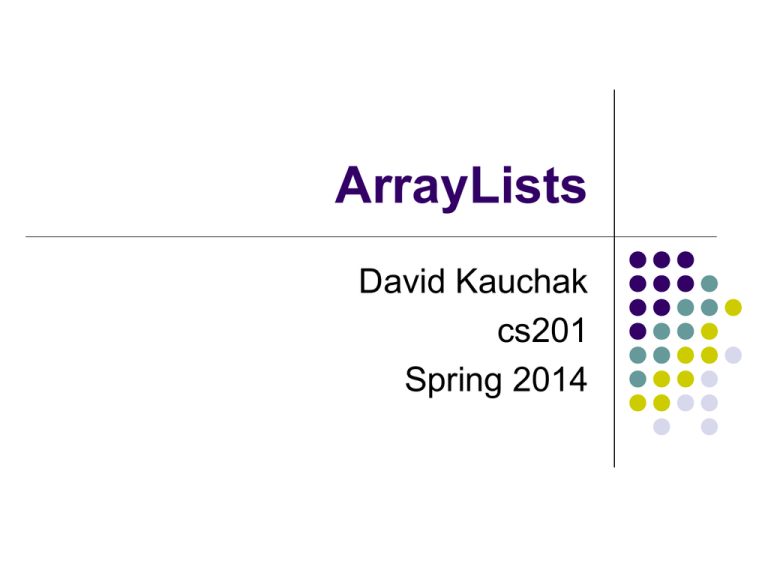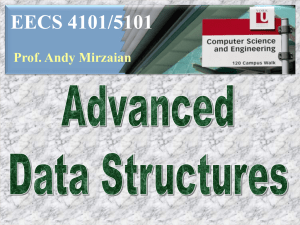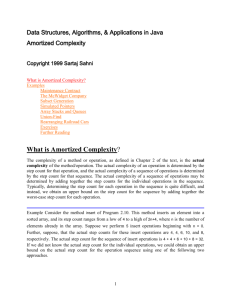ppt
advertisement

ArrayLists David Kauchak cs201 Spring 2014 Extendable array Arrays store data in sequential locations in memory Elements are accessed via their index Access of particular indices is O(1) Say we want to implement an array that supports add (i.e. addToBack) ArrayList or Vector in Java lists in Python, perl, Ruby, … How can we do it? Extensible array Idea 1: Each time we call add, create a new array one element large, copy the data over and add the element Running time: O(n) Extensible array Idea 2: Allocate extra, unused memory and save room to add elements For example: new ArrayList(2) allocated for actual array extra space for calls to add Extensible array Idea 2: Allocate extra, unused memory and save room to add elements Adding an item: Running time: O(1) Problems? Extensible array Idea 2: Allocate extra, unused memory and save room to add elements How much extra space do we allocate? Too little, and we might run out (e.g. add 15 items) Too much, and we waste lots of memory Ideas? Extensible array Idea 3: Allocate some extra memory and when it fills up, allocate some more and copy For example: new ArrayList(2) … Extensible array Idea 3: Allocate some extra memory and when it fills up, allocate some more and copy For example: new ArrayList(2) … Running time: O(n) Extensible array Idea 3: Allocate some extra memory and when it fills up, allocate some more and copy For example: new ArrayList(2) … How much extra memory should we allocate? Extensible array Idea 3: Allocate some extra memory and when it fills up, allocate some more and copy For example: new ArrayList(2) What is the best case running time of add? O(1) What is the worst case running time of add? O(n) Can we bound this tighter? Extensible array … Challenge: most of the calls to add will be O(1) How else might we talk about runtime? What is the average running time of add in the worst case? Note this is different than the average-case running time Amortized analysis What does “amortize” mean? Amortized analysis There are many situations where the worst case running time is bad However, if we average the operations over n operations, the average time is more reasonable This is called amortized analysis This is different than average-case running time, which requires reasoning about the input/situations that the method will be called The worse case running time doesn’t change Amortized analysis Many approaches for calculating the amortized analysis Aggregate method figure out the big-O runtime for a sequence of n calls divide by n to get the average run-time per call Amortized analysis Assume we start with an empty array with 1 location. What is the cost to insert n items? total_cost(n) = basic_cost(n) + double_cost(n) CHALKBOARD Amortized analysis Assume we start with an empty array with 1 location. What is the cost to insert n items? total_cost(n) = basic_cost(n) + double_cost(n) basic_cost(n) = O(n) total_cost(n) = O(n) double_cost(n) £ 1+ 2 + 4 +8+16 +... + n = 2n amortized O(1) Amortized analysis vs. worse case What is the worst case for add? Still O(n) If you have an application that needs it to be O(1), this implementation will not work! amortized analysis give you the cost of n operations (i.e. average cost) not the cost of any individual operation Extensible arrays What if instead of doubling the array, we increase the array by a fixed amount (call it k) each time Is the amortized run-time still O(1)? No! Why? Amortized analysis Consider the cost of n insertions for some constant k total_cost(n) = basic_cost(n) + double_cost(n) basic_cost(n) = O(n) double_cost(n) =k+2k+3k+4k+5k+...+n n/k =å ki i=1 n/k =kåi i=1 næn ö ç +1÷ kèk ø =k = O(n 2 ) 2 Amortized analysis Consider the cost of n insertions for some constant k total_cost(n) = O(n)+O(n2 ) = O(n 2 ) amortized O(n)!











